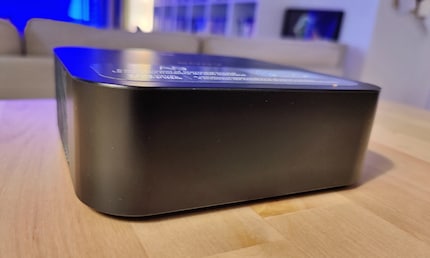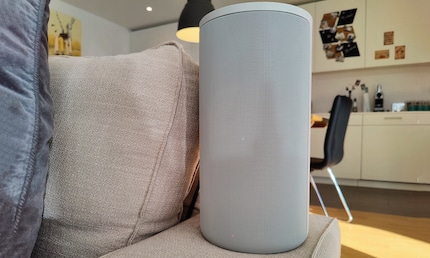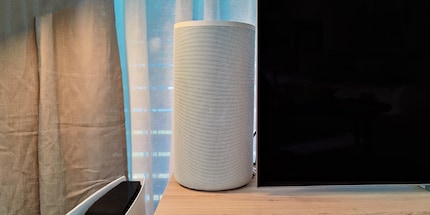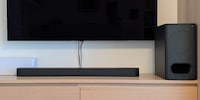

HTA9: testing Sony’s «revolutionary» Dolby Atmos system
Four speakers that trick you into thinking there are 12 of them. Revolutionary? No. But it still sounds impressive.
Sony’s new sound system works in an unconventional way. Where I’d expect a soundbar, there are, in fact, four large speakers and a mini computer in the form of a box. With it, Sony promises to deliver the best soundscape for home cinema systems in its price range.

The Japanese manufacturer actually wants to lower its drawbridges. The HTA9 is aimed at anyone who’s been ogling soundbars because of their affordability. A much more expensive home cinema system above the 5,000-franc mark – Klipsch and their ilk, for example – is out of the question for most of us, after all. At the same time, the HTA9 aims to set itself apart from soundbars in terms of sound quality – even the expensive ones. That’s why it’s got four speakers, which aren’t exactly fun-sized, but still aren’t as hefty as the cupboard-like speakers of a home cinema system.
Read on to find out whether Sony’s mission has been a success.
Huge but stylish
Assembling the system is straightforward. Based on where I was sitting, I mounted the speakers in front of me roughly to the left and right, doing the same with the ones behind me. The exact positioning isn’t that important, as the software takes care of that later. This is controlled by the processor, which is housed separately in a small box.
A sound system’s processor has an important job. Especially when you’ve been promised a room-filling sound with sophisticated 3D effects. Even if, as is the case with soundbars, there are no additional speakers in the room. Manufacturers keep this promise by digitally manipulating sound with complex calculations and algorithms. Here’s where the processor comes into play. The more powerful it is, the more complex the algorithms are – and the sound is noticeably better.
The fact Sony even gave the processor its own box says a lot about its computing power – just like with a receiver. That’s a good thing.

Next, I select automatic sound field optimisation in the speaker menu. This only needs to be done during the initial set-up. Think of it as an imaginary dome that’s been plopped on top of you. The speakers emit strange sounds at first, which reverberate off the walls, windows and ceiling. The microphone then recaptures the sound waves. Using the resulting data, the processor creates an acoustic image of the room. That’s how it optimises the sound field – the «dome» – regardless of where the speakers are positioned.
Here’s the kicker: as well as the four physical sound channels in the form of speakers, there are eight additional virtual sound channels. So, 12 sound channels altogether:
- two at the front
- two at the sides
- two at the rear
- four overhead
- two subwoofers
And there you have it: a sound field with a 6.2.4 system. It’s got a nominal power of 504 watts in total.
Sound field optimisation from 9 seconds. There’s no need to run around the living room waving your smartphone.
One thing about the speakers: the beige, four-kilogramme cylinders don’t go unnoticed. They just about manage to squeeze onto my TV unit along with my 65-inch TV. Still, I think they’re stylish. I like the cylindrical shape and grille design. The fabric covers often seen on speakers, which attract dust as sure as light attracts moths, are a no-no for me.
The box and speakers are supplied with power by a cable. If you’re flirting with the idea of buying an HTA9, you should bear in mind that you’ll need plenty of available power outlets and extension cables. However, the processor box itself doesn’t require any other cables. The speakers communicate with one another via Wi-Fi. The box is, in turn, connected to the TV using the HDMI cable included with the system. This is how the sound reaches the box, and from there via Wi-Fi, the speakers. If you use the HTA9 to listen to music, for example on Spotify, it all runs via Wi-Fi anyway.
What’s hiding under the hood? Plenty of good stuff!
Here’s the thing about processors, which manipulate sound digitally: if sound were a muscle – a digital muscle – too much digital manipulation would be anabolic steroids. In short, the sound seems artificial. Or kind of otherworldly. It lacks that warm, fuzzy feeling you get when you hear sound or music. That’s why the drivers built into the speakers are just as important as the processor. They relay the sound and make it seem natural despite the digital manipulation.
Sony has built the following into each speaker:
- a front-firing soft dome tweeter for high frequencies.
- a wide-dispersing elliptical woofer for mid frequencies and bass.
- a top-firing speaker for sound coming from above.
- two microphones for sound field optimisation and voice control (Google Assistant and Alexa).

Speaking of which – here are the ports:
- 1× HDMI 2.1 output, ARC and eARC-enabled
- 1× HDMI 2.1 input
- 1× LAN
- 1× large S-center output
- 1× USB interface for updates via USB stick
- Built-in Chromecast
- Bluetooth 5.0
Unlike competing products, for example the Sonos Arc, you get an additional HDMI port here. To that, I say «halleluja». I actually have so many external devices that the four HDMI inputs you get with most TVs haven’t been cutting it for a while now. So, the added plug-in option provided by the box is more than welcome.
Another welcome feature? The supported sound formats:
- Dolby Atmos
- Dolby TrueHD
- DTS-X
*DTS digital surround
- 360 reality audio
- FLAC, ALAC and DSD
When watching TV, sound formats with few channels – for example, stereo – are automatically scaled up and distributed among up to twelve sound channels. I’ll come back to that later. When listening to music, however, less qualitative formats are scaled up to DSEE Extreme if music is being streamed on the speakers via Wi-Fi. If these abbreviations are all Greek to you, DSEE Extreme is pretty close to high-quality, hi-res formats. Regardless of what you’re listening to on the HTA9, it’ll sound pretty good.
That’s the theory, here’s the reality
Time to put all that theory into practice. I kick things off with «The Tomorrow War». The film, starring Chris Pratt in the lead role, tells the story of a war fought and lost in the future. As a consequence, people travel to the past – our present – to grab reinforcements in the form of cannon fodder. This is exactly where my test setting begins. It’s particularly challenging for sound systems because the sound in this scene is supposed to come from above – it’s vertical sound.
Source: Amazon Prime Video. Sound: English, Dolby Atmos
It billows and booms around me while lightning bolts and crimson energy fields blast open the portal to the future. Then, with a loud bang, a wormhole opens up above Chris Pratt and the other soldiers – a bang that feels as if it’s come from right above my head. The vertical sound isn’t just good. It’s brilliant. One soldier after another is sucked into the wormhole, their yelps of shock echoing. Again, I marvel at the vertical sound. Then, it’s Chris Pratt’s turn. His flight through time and space fills my living room with sound. It booms and whooshes. There’s lightning and thunder. The group leaps into the future. What comes next knocks me for six.
Pratt, myself and a dozen other time travellers suddenly find ourselves hundreds of metres above ground, in the middle of a cloud – and then we fall. The wind whistles all around us. The screams, too. First from the front boxes, then from the rear ones. Pratt looks down. Roofs are rapidly coming up to meet him; they must be skyscrapers. The first hapless soldiers crash onto the hard stone. Bones break, bodies are squashed. The bass rumbles. Lightning is still striking all around me. Then I see some people missing the roofs, falling further and further. Their screams are fading. The hairs on the back of my neck are standing on end.
Pause.
I’ve buried myself into the sofa in sheer horror. I change the film to «Blade Runner 2049». Ryan Gosling searches for clues about his true identity among the ruins of San Francisco. His shuttle flight is going smoothly, with cinematographer Roger Deakins’ images packing a punch. Especially with Hans Zimmer’s Vangelis-like music blaring from the boxes. Deep. Gentle. Different. Like that infinite sense of calm just before waking up, which you keep trying to hold on to before your eyes open.
Source: UHD Blu-ray. Sound: English, Dolby Atmos
It’s raining. Big, heavy drops patter on the windscreen of the shuttle – the sound from the two speakers in front of me is muffled, yet harsh at the same time. Then, the perspective changes – as does the soundscape. The shuttle is now seen from the outside. And the rain sounds different. More comforting. It fills my entire living room as if I were sitting in the heart of a forest on a cool, autumn day, hearing every drop falling onto the leaves around me.
The soundscape stops suddenly. A deceptive calm takes hold: the shuttle’s power has been cut off from the outside. Silently, it tilts downwards. Then there’s a whooshing sound, which shoots across my shoulder, from the front-left speaker to the back-right one. Someone has shot at the shuttle – at me! – and missed. I only have a little bit of time to enjoy the sheer precision of the audio. Why? Another shot is fired. This time, it hits its target. The speakers screech. Something has broken. In the film, not the speakers. The shuttle isn’t floating anymore. It plummets.
I tear myself away from the film again.
A hefty price tag that’s wholly justified
I could go on forever with examples like these. What’s certain is that not even my Sonos Arc with its two speakers or my subwoofer can hold a candle to the HTA9. Sonos products were my reference point for complete home cinema systems around the 2000-franc mark.
Sony’s HTA9 sounds not just more impressive, but more precise. This is especially the case when it comes to vertical sound, which is where the difference compared to my personal set-up is most pronounced. That’s not much of a surprise: while the Sonos Arc soundbar at my place only has two top speakers, Sony’s HTA9 has four speakers. And they’re larger to boot. This in turn creates more of a boom, which allows the sound to fill the room without much digital manipulation. Another boon for the HTA9.
Let’s not forget the price tag. At the time of writing this review on 13 January 2022, the HTA9 costs around 1999 francs. Not cheap, but still less than the 2150 francs you’d currently have to cough up to get a Sonos home cinema set-up. And it sounds even better. I only occasionally had to deal with short drop-outs – interruptions, which were possibly down to interference from the Wi-Fi. That said, they didn’t last long enough to have a significant impact on my opinion.

Verdict: highly recommended
Sony promised me a sound revolution when it handed over my test device. I wouldn’t put it in such euphoric terms, but the HTA9 still wowed me nonetheless. It was easy to set up and the speakers look good, too. And its sound really is superior to the home cinema system and soundbar I have at the moment – even if you couldn’t describe the difference as revolutionary.
Your heart might skip a few beats when you see the price. Not if you’ve previously bought a Sonos, though – then you’ll be used to expensive stuff. However, the Samsung HW-Q950A appears to be comparable, at least on paper – and costs «only» 1299 francs. I haven’t tested it yet, so I can’t draw any comparisons. Maybe I’ll try it out next.
I write about technology as if it were cinema, and about films as if they were real life. Between bits and blockbusters, I’m after stories that move people, not just generate clicks. And yes – sometimes I listen to film scores louder than I probably should.


